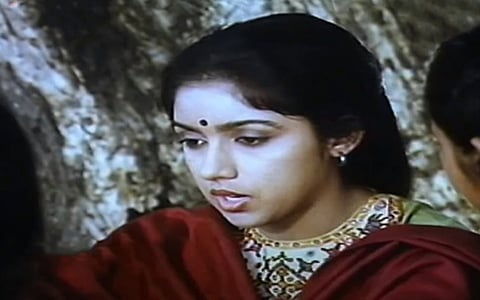
- Reviews
- Power List 2024
- Cannes 2024
- In-Depth Stories
- Web Stories
- News
- FC Lists
- Interviews
- Features
- FC SpecialsFC Specials

The first 15 minutes of Mani Ratnam's Mouna Ragam help the viewer fully grasp the character of the film's female protagonist Divya, played by Revathy. Not a single second of screentime gets wasted, as the director conveys Divya's playfulness and her contempt for both love and marriage.
In the opening scene, a high-spirited Divya, with the help of equally sprightly kids, splashes a tub of water to interrupt her brother and sister-in-law's stolen moment of intimacy. In the next scene, the obedient Divya, through a cleverly used exposition, speaks her father's mind about her, revealing how a person other than Divya might view someone like her.
When Divya's father hesitantly reveals that a potential groom is visiting the family later in the day, the two-wheeler comes to a stop in the middle of nowhere, signifying that Divya's fun-filled life is coming to a sudden halt.
Cinematographer PC Sreeram shoots Divya walking past the other girls in her college: their happy faces and Divya's gloomy look provide a complete contrast, visually showing Divya as someone who is not part of a crowd. The use of voiceover juxtaposing with the visuals where Divya's father reassuringly speaks only about the positives of the alliance, further establishes Divya's keen interest in wanting to walk away from this association, something that other girls would happily accept.
Seated under a tree, a firm Divya tells her group of friends that she would never marry a stranger. Mani Ratnam shows Divya's contempt for the concept of arranged marriage through the following dialogues:
Avan kaal la vizhu-nu solluvaanga. Appram paatu paadu-nu solluvaanga. Appram avanuke kazhutha neetu-nu solluvaanga. Munna pinna theriyadha evano orthuna kalyanam pannika naan thayaara illa. Appadi kalyanam panni kashta padradha vida thaniya ve irundhudalaam.
(They will ask me to fall at his feet. Then, they will ask me to sing a song. And then, they will ask me to marry him. I am not ready to marry a stranger. It would be better to remain single than getting married thus.)
The amalgamation of Divya's character trait and her views on love and marriage are shown in the song Oho Megam Vandhadho that follows this scene.
Tamil cinema directors use songs for various reasons, with one of the more logical reasons being to show the passage of time involving love, grief, growth, etc. Mani Ratnam uses Oho Megam Vandhadho, written by Vaali, as a character establishment song.
Oho Megam Vandhadho is an extension of the preceding scenes, or one can even call the song the final piece of the puzzle that Mani Ratnam fits into the film to strike home Divya's character. The three parts of the song — the pallavi, first charanam and second charanam — show Divya's free-spirited nature and her opinion on love and arranged marriage.
The fun, celebratory song's pallavi has Divya singing the lines and getting herself drenched in the rain, symbolising independence.
In the interlude before the first charanam, a group of men cycles around the dancing girls. Divya follows them after they leave and removes their hats, showing she's not afraid to take on men. The lightness of the proceedings goes well with the song's mood.
The first charanam conveys Divya's stance on arranged marriage:
Naan pennanadhu kalyanam thedava
Oh kannaalan vandhu poomaalai podavaa
Yaen ammaadiyo pen paarkum naadagam
Yaar vandhaalumenna
Thirumbaadhu nyabagam
Poovilangu thevaiyillaiyae
(Did I become a woman to get hitched?
For a man to come and garland me?
Oh why, this match-making drama?
Let anyone come, I won't lose sight of my memories,
There's no need for 'floral' handcuffs.)
These lines show that the whole drama involving a stranger slipping a pair of handcuffs on her, even if made of flowers, is not why she grew up to be an independent, well-educated woman.
The second charanam serves as Divya's take on love:
Kaalgal yengeyum odalaam, kaadhal illaamal vaazhalaam
Vanna minnalgalai nindraadalaam, vaazhvil sangeedam paadalaam
Naam innaalilae sittaaga maaralaam, vaa sevvaanam indru jivvendru yeralaam
Naam yellorumae semmeengal aagalaam, vaa neerodai yengum vellottam pogalaam
Vaazhkai yenna vaazhndhu paarkalaam
(The feet can go anywhere, one can live without love,
Let's dance as colourful lightning, let's sing in life.
Let's transform into birds, and soar into the red dusk sky,
Let's transform into small fish, let's test ride the waterfall.
Let's experience life.)
Through these lines, Divya comes across as a person who does not want to be in love. She does not want to stop in her tracks; she wants to dance to her tunes; she wants to fly; she wants to live her life. Anything but love for her is equivalent to living a life.
In his interview with film critic Baradwaj Rangan, Mani Ratnam revealed that he wrote Manohar's character as an afterthought, to reach a wider audience. Even if Manohar's character was not present in the original script, the opening scenes, including the song, perfectly capture Divya's colorful personality. They perfectly justify her motivations for not wanting to marry a total stranger. Because, for Divya, love itself is a…Mouna Ragam (silent symphony).